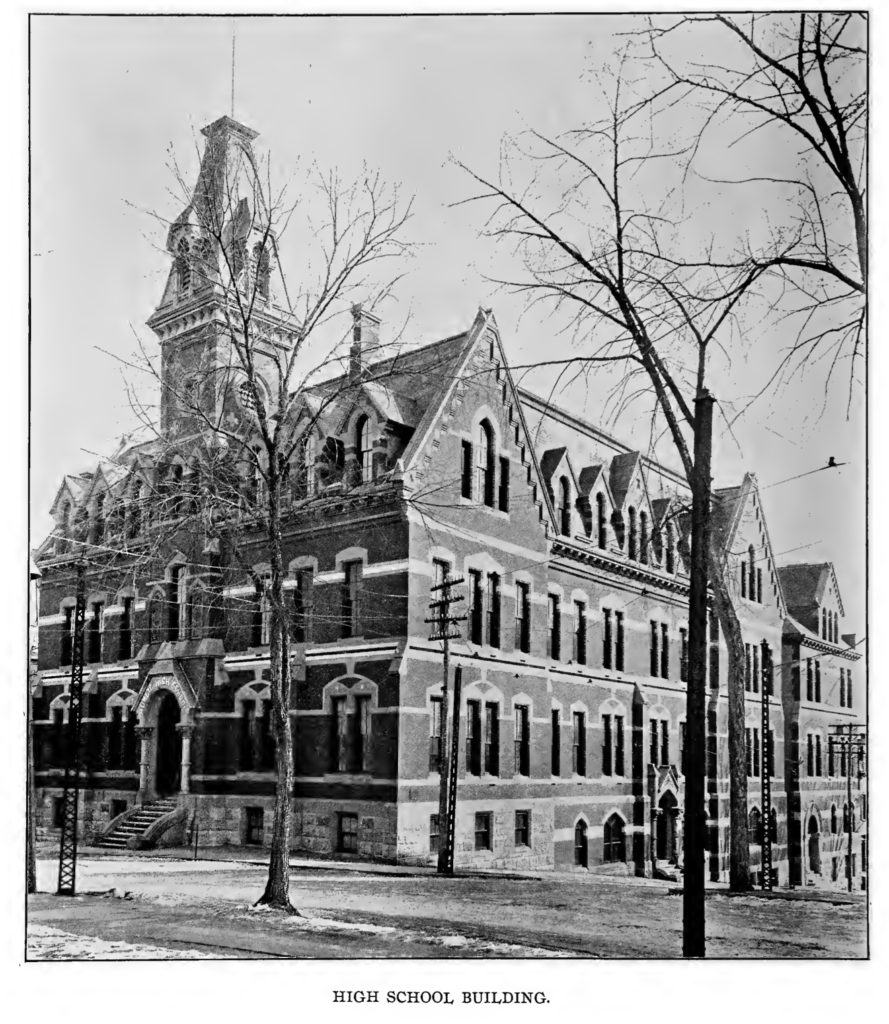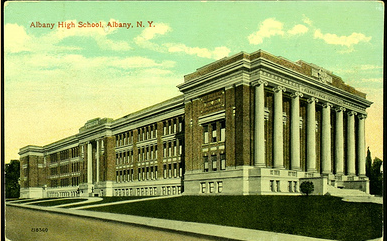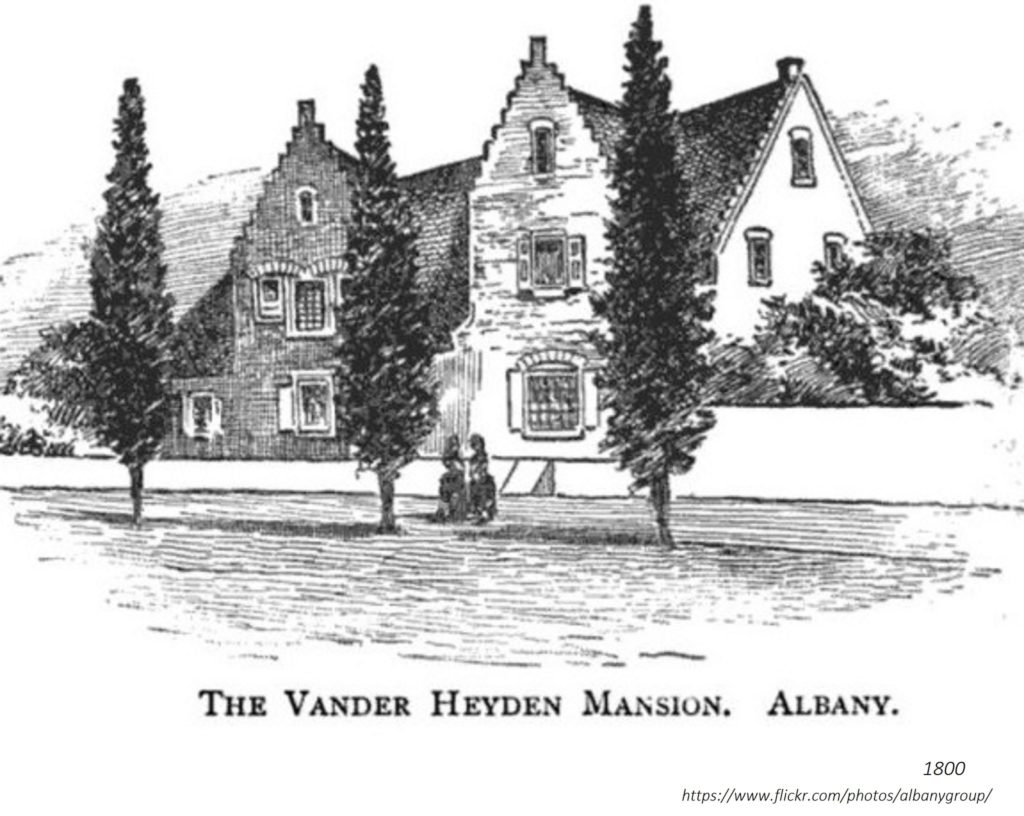Continuing with our series on the bicentennial tablets placed around the city of Albany in honor of the bicentennial of its charter, we come to one that’s a little unusual in that its copy primarily quotes a license granted by the colonial governor to the first teacher of English in Albany.
As described by the Bicentennial Committee:
Located on the High School building – Bronze tablet, 16×22 inches, in face of front wall:
“The Governor’s License Granted Unto John Shutte for Teaching of the English Tongue at Albany: Whereas, The Teaching of the English Tongue is necessary in this Government, I have therefore thought fitt to give Licence to John Shutte to be the English Schoolmaster at Albany. And upon Condition that the said John Shutte shall not demand more Wages from Each Scholar than is customarily given by the Dutch to their Dutch Schoolmasters. I have further granted to the said John Shutte that hee shall bee the only English Schoolmaster at Albany. Given under my hand at Fort James in New York the 12th day of October, 1665. RICHARD NICOLLS, Governor.”

This placement would have been the Albany High School that stood on Eagle Street between Steuben and Columbia, where the Albany County Courthouse currently stands. That building was only there from 1876 to about 1915, just around the time the Argus reviewed the state of the bicentennial tablets in 1914, when this tablet was one of the ones they noted had been removed because of alterations or demolition. They said, “No. 21, commemorating the first English schoolmaster, is to be placed in the new High school, there being nothing in the inscription which would necessitate its being retained in any fixed locality.”
It seems a little odd that it was removed a bit early; the next new high school, now a part of the SUNY Albany downtown campus, opened in 1915, and the old high school on Eagle was replaced by the Albany County Courthouse in 1916, but perhaps construction started earlier than that and necessitated removal of the marker. In 1910, the Argus said the marker was on the Steuben Street wall of the school, and in 1914 it was gone.
After first publishing this article, we found a reference to this marker in the October 3, 1915 Albany Argus. While primarily concerned with the fate of the markers on Broadway in the area of the Plaza, it noted that City Engineer Lanagan had the tablet but didn’t know quite where to put it:
“A tablet which is now reposing in the office of City Engineer Lanagan and which was taken from the old High school when it was torn down and which is known as ‘First English Schoolmaster,’ has been giving Mr. Lanagan considerable worry. He does not know just where to put it and he is open to suggestions.”
We found no evidence Mr. Lanagan ever resolved his problem, or that it ever actually made it to the new high school; in fact, in 1936 the Albany Evening News reported that the Board of Education wanted to find the original plaque “and place it with other plaques in the Joseph Henry Memorial, the former Albany Academy building reconstructed as the administration center of the city school department.” If it turns out it did find its way there, please let us know.

As for what was being commemorated – as the license from Governor Nicolls made clear, Shutte was far from the first schoolteacher in Albany; he was simply the first to teach English. The timing was not coincidental – Nicolls had led the capture of New Netherland for England in August 1664, and became the first English governor of the colony he renamed New York. He imposed English systems of law, not surprisingly, and in trying to make a Dutch colony English, promoting the teaching of English would have been a natural priority. We find it odd and interesting, though, that the Albany Bi-Centennial Committee would have found the first licensed English teacher to be of such significance in a city that was usually proud of its Dutch heritage. Perhaps it was just the convenience of having a name, for it’s not clear that they knew the names of any of the earlier Dutch schoolmasters; perhaps it was because Albany’s charter itself was also granted by an English governor, Thomas Dongan, some years later. In any event, the tablet memorialized Shutte.
Other details about Shutte are not to be found – we don’t know where he taught, or how long.
In 1926, The Knickerbocker Press gave a detailed history of education in Albany, and it said that the first formal education in Albany began in September 1650 – “it was then that Andraas Jansen was chosen teacher of the school in connection with the church of Fort Orange under the pastorate of Reverend Wilhelmus Crasmeer.” That was a good 15 years before Shutte came to teach English. The Press’s review of education then jumps to 1721, when Johannes Glansdorf offered to settle in Albany and keep a school “if reasonably encouraged by ye Corporation,” and the commonalty agreed to give him free house and rent for seven years “for keeping a good and commendable school as becomes a diligent Schoolmaster.”

Residents of the city and county petitioned the common council to be allowed to establish a seminary in 1779, and Philadelphia’s George Merchant was engaged to conduct the school, which opened November 16 in the VanderHeyden palace, subject of another historical marker, and now the site of Ten Eyck Plaza.

The next big development in education was the Lancastrian school, founded in 1812. We’ve written a bit about the Lancaster system as it was developed in Schenectady, a minimal investment in teacher resources that relied on older (or simply more experienced) students teaching what they had learned to the next class below them. There were 400 students in Albany’s Lancaster school by 1817, when it moved to a building that later became the Albany Medical College, on Eagle Street. The school was discontinued in 1834, according to the Knickerbocker Press.
Real public education as we would recognize it began in 1830 when the State legislature authorized election of a board of school commissioners, and a board of school inspectors, and the city was divided into nine school districts. They first school building, District School No. 2, was built on State Street in 1832. The system had grown to 15 schools, with 6,045 registered students (daily attendance of 4,037) by 1866.
The first high school came in 1867, with the Albany Free Academy, with 149 boys and girls meeting in Van Vechten Hall on State Street. In 1876, the gorgeous high school building on Eagle Street between Columbia and Steuben opened and was used, despite severe overcrowding, until the next high school on North Lake opened in 1913. (More on the history of that first high school in this post.)
We found no evidence that the marker made it to the new high school. It’s certainly not on the building now. And we have no confirmation it ever made it into the Joseph Henry building either.
And we find it odd and telling that the Bicentennial committee chose to honor the granting of a license over the actual act of teaching.

Leave a Reply